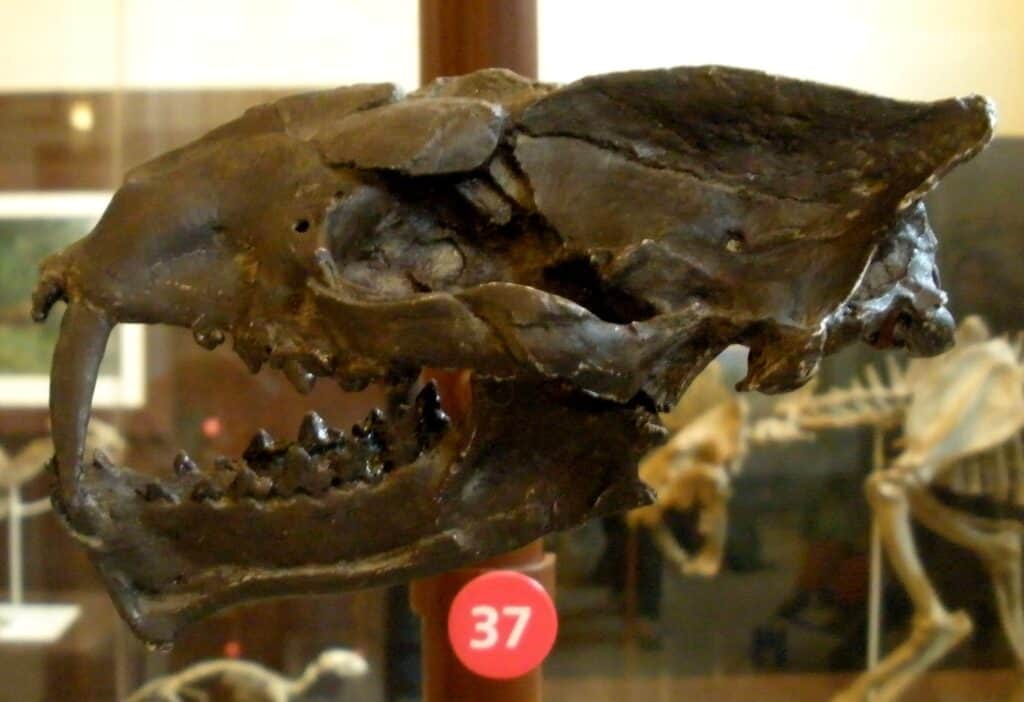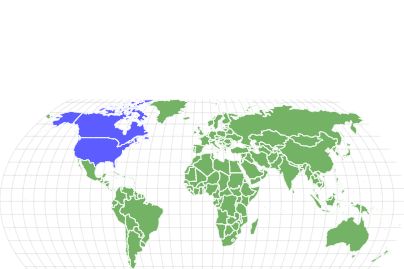Machaeroides
M. eothen, M. simpsoni
Machaeroides had large saber-teeth, much like the saber-toothed tiger.
Advertisement
Machaeroides Scientific Classification
- Kingdom
- Animalia
- Phylum
- Chordata
- Class
- Mammalia
- Order
- Oxyaenodonta
- Family
- Oxyaenidae
- Genus
- Machaeroides
- Scientific Name
- M. eothen, M. simpsoni
Read our Complete Guide to Classification of Animals.
Machaeroides Conservation Status
Machaeroides Facts
- Prey
- Large Ungulates
- Main Prey
- Horses, Ancient Rhinoceroses
- Fun Fact
- Machaeroides had large saber-teeth, much like the saber-toothed tiger.
- Biggest Threat
- Larger carnivores, food scarcity
- Most Distinctive Feature
- Large teeth used for crushing and puncturing prey
- Distinctive Feature
- Dog-like size
- Habitat
- North American Plains
- Predators
- Large, Eocene Carnivores
- Diet
- Carnivore
- Favorite Food
- Larger Herbivores
View all of the Machaeroides images!
This intriguing hunter is often compared to a doglike saber-toothed tiger. Machaeroides was neither canine nor feline, however. It belonged to a clade of animals that has since gone extinct.
We’ve compiled all you need to know about this unique Eocene Epoch animal. Let’s travel back 50 million years and explore the Machaeroides genus.
4 Facts about Machaeroides
- Machaeroides literally means “dagger-like”
- A member of the extinct Oxyaenodonta order
- Saber-toothed, with no relation to big cats
- Different subspecies ranged from 20 to 35 pounds in weight
Description & Size
Machaeroides was a genus containing two subspecies: M. eothen and M. simpsoni. The genus name Machaeroides means “dagger-like,” referring to the characteristic teeth of this ancient predator.
These animals were saber-toothed, although they had no close relation to big cats or saber-toothed tigers. Instead, Machaeroides fell into the Oxyaenodonta order, while cats and dogs split into the Carnivora order.
Oxyaenodonta and its sister order, Hyaenodonta, were both branches of the Mammalia class, although both orders are now extinct. Oxyaenodonta and Hyaenodonta mean “sharp hyena” and “hyena teeth,” respectively. These two categories of animals were very similar, and both would have included animals that looked vaguely like hyenas.
Machaeroides was a dog-sized saber-toothed animal, weighing roughly 20-35 pounds. Of the M. eothen and M. simpsoni, the former would have likely maxed out in weight at around 30 to 35 pounds. M. simpsoni is thought to have been a little smaller.
For a little context, most Terriers fall into the 20-30 pound range. It’s funny to imagine a little Scottish Terrier with saber teeth, but Machaeroides would likely have been a little more threatening to look at.
Locomotion
Its posture would’ve been less familiar, and these creatures certainly weren’t domesticated or docile. Further, it had a plantigrade walking style, meaning that it pressed down on the entire foot (much like humans) rather than planting on its toes like cats or dogs. Bears and many weasels walk with plantigrade locomotion, to give you some perspective on Machaeroides‘ movement.
The benefit of this type of locomotion is the ability to sustain more weight or resistance. Plantigrade animals are slower, but they can plant themselves firmly in position.
Imagine a giant Grizzly Bear pressing its feet into the mud in anticipation of a charging rival. Two large bears press into one another, throwing all of their weight, and somehow remain planted. It’s very impressive, and it’s thanks to the position of their feet.
Now imagine a giant bear with the feet of a cat, perching on its tip-toes. It would be a lot harder to hold weight when fighting or attacking prey.
So, Machaeroides would have had the same abilities, although it might not have been able to stop a charging bear. Instead, this animal used its weight-bearing feet to press into large ungulates like ancient horses and small rhinoceroses.
- Plantigrade style of walking
- Ambush predator
- Slow runner
- Firm stance used for hunting larger prey
Saber Teeth
A “saber” is a large sword used by cavalries or military groups in antiquity. Any saber-toothed animal, then, is equipped with two large canine teeth. You have canine teeth, too (they’re the pointiest ones in your mouth).
Machaeroides was certainly a member saber-tooth hall of fame, with large canines shooting disproportionately far out of its mouth in relation to its body. These massive teeth would have served the purpose of penetrating deep into the flesh of its prey.
The dental profiles of discovered Machaeroides mandibles (jaw bones) show more strength in the canines than in the upper cheek. Alternatively, the close-cousin Hyaenids show a stronger cheek profile, suggesting smaller bites used to subdue prey. This attack style takes prey down, allowing more time to make the kill when other pack members arrive.
Hyaenids, then, might have used a pack-killing strategy.

The skull of Machaeroides eothen | Image:
Wikimedia Commons
©By Ghedoghedo – too
Researchers suggest that more force present in Machaeroides‘ canine teeth implies “powerful canine bites to kill their prey[.]” This means that Machaeroides individuals were likely ambush predators and may not have needed to hunt in large groups.
Their attacks would have aimed to kill prey right away rather than subduing prey and killing with the help of other individuals.
- Teeth resemble swords
- Large canines penetrated deep into prey
- Strength in canine teeth suggests that Machaeroides was an ambush predator
Posture and Appearance
Fossil evidence from Oxyaenodonta and Hyaenodonta discoveries suggest that Machaeroides would have presented themselves with a flat, horizontal posture. The spine would have run almost horizontal, extending straight out to the neck and skull.
They’re also thought to have had an extended neck similar to the Hyena, although Machaeroides‘ head would have plunged down toward the ground whereas the Hyena rests its neck at more of a 45-degree upward angle. Due to the size of its legs, Machaeroides‘ body was lower to the ground proportional to the size of its body.
Again, Machaeroides is closer in nature to a weasel than a cat in this way. If using domesticated dogs as a comparison, you could think of Machaeroides as having more of a Dachshund posture than that of a Pit Bull or Terrier.
- Posture distinct from dogs, closer to weasels
- Would have resembled Hyenas in some ways
Diet – What Did Machaeroides Eat?
Machaeroides evolved to take down prey that was much larger than itself. The Eocene Epoch lent itself to thriving large ungulates and herbivores in North America.
Animals like Orohippus (“mountain horse”) and the rhinoceros-like Megacerops (“large-horned face”) would have roamed the same territories as Machaeroides. These animals were accompanied by numerous other horse-like and rhino-like creatures during the Eocene.
Despite the difference in size, these ungulates would have been the perfect prey for Machaeroides. If, in fact, Machaeroides hunted with companions, individuals would have been able to take down much larger prey.
That said, if researchers are right and this small saber-toothed predator hunted alone, there would have been all manner of small or mid-sized animals to hunt in prehistoric Wyoming and the surrounding areas.
- Machaeroides hunted larger herbivores (mostly smaller, horse-like animals)
- Prey could have been very large if Machaeroides hunted in packs
- Many mid-sized herbivores shared the environment
Habitat – When and Where It Lived
The Eocene Epoch lasted from roughly 54.9 million years ago to 46.2 million years ago. This is when Machaeroides lived, although the exact date of its emergence and extinction aren’t extremely well documented or understood.
Based on the known fossil specimen, specifically, Machaeroides could have lived anywhere from 55.8 million years ago to 46.2 million years ago. Again, that’s based on the fossils that have been discovered, and there are very few discoveries.
So far, the only Machaeroides fossils have been found in the state of Wyoming in the United States. It’s unlikely that they were limited to this territory, though. Fossil evidence might emerge more readily in the area of Wyoming due to geological aging specific to the region.
Continents were arranged in the same way they are now during the Eocene, although the climate would have been much different. The period was marked by a particularly low amount of ice on the planet resulting in a relatively warm, steady temperature around the globe.
Northern and southern regions would have been colder, although the difference in temperature between the poles and areas around the equator would have been much smaller than it is now. So, Machaeroides would have lived in a warmer Wyoming ripe with plenty of grasses and vegetation for its prey to eat.
- Lived in the Eocene Epoch (55.8 to 46.2 million years ago)
- Very little fossil evidence
- Existing fossils come from Wyoming
- Would have lived in a slightly warmer climate
Threats and Predators
While Machaeroides was a formidable hunter, it would also have been hunted in its day. The North American Eocene was home to many early predators including budding members of the big-cat family and even some large canines.
That said, most of these individuals would have been roughly the same size as Machaeroides, as this new cohort was just emerging and finding its place in the world. There was, however, a large predator called “Sarkastodon” that was a cousin of Machaeroides. This carnivore would have been more than happy to feed on its little cousin.
The Sarkastodon was sort of a monstrous bear-weasel hybrid. It would have been tough for most animals to successfully attack and hunt Machaeroides as a viable prey source, though.
The true threat to this animal was something called the Eocene-Oligocene extinction event, which we’ll look at a little further on.
- Probably had a small set of predators
- Would have rested toward top of the food chain
- May have been hunted by Sarkastodon
Discoveries and Fossils – Where was It Found?
As we’ve noted, the primary discoveries of Machaeroides were found in different areas of Wyoming. Let’s take a closer look at each of those three discoveries.
M. eothen fossils were discovered at the Rock Springs Uplift in Sweetwater County, Wyoming. This area is a hotbed for fossil discoveries as well. Dozens of other species have been located in this particular region of Wyoming.
Further east, M. simpsoni specimens have been found at locations called Barwin Quarry and Davis Ranch, respectively. These two areas are fewer than 50 miles apart and are also host to dozens of discoveries from the Eocene and Paleocene.
The first discovery was in 1909, and subsequent discoveries were made in 1967 and 1998.
- Three key fossil discoveries in Wyoming
- Uncovered in 1909, 1967, and 1998, respectively
- Fossil discoveries very close together
Extinction – When Did It Die Out?
While relatively little is known about Machaeroides’ history, we can assume that the Eocene-Oligocene extinction event might have had something to do with the extinction of the species.
It seems that some Oxyaenodonts and Hyaenodonts survived this event and lived millions of years into the Miocene which came after the Eocene. That said, we don’t have evidence to show that this was the case for Machaeroides.
The bulk of the Eocene-Oligocene extinction event impacted marine life, although it did have a significant effect on the climate which then shifted enough to disrupt the existence of land mammals. This dying out and redistribution of land mammals is called The Age of The Grande Coupure.
So, while we don’t know exactly what happened to these saber-toothed hunters, fossil evidence places them as recently as 46 million years ago. More insight will come from future discoveries, giving Machaeroides more context in the grand scheme of things.
- Little is known about Machaeroides’ extinction
- Certainly lived as recently as 46 million years ago
- Might have died out during Eocene-Oligocene extinction
Animals Similar to Machaeroides
- Saber-Toothed Tiger – While these animals weren’t related, they had similar saber canine teeth extending out to pierce prey.
- Hyena – Machaeroides probably looked something like a small Hyena.
- Sarkastodon – Sarkastodon was another Oxyaenodont during the Eocene. It was much larger and higher on the food chain than Machaeroides, however.
Frequently Asked Questions
Want to Learn More About Similar Animals?
- Meet The holy Grail of Ice Age Fossils: The La Brea Tar Pits
- The Quaternary Period: Animals, When It Happened, and Major Events
- Paleogene Period: Animals, When It Happened, and Major Events
- Discover 6 Extinct Animals That Lived in South Carolina
Machaeroides FAQs (Frequently Asked Questions)
Did Machaeroides evolve?
We’re not sure if Machaeroides evolved beyond the point of M. simpsoni or M. eothen because fossil evidence doesn’t exist to give researchers those insights. However, we do know that the line of Oxyaenodonts went extinct, so there are no surviving animals related to this ancient saber-toothed carnivore.
Did Machaeroides have wings?
Although there are some rumors that Machaeroides had wings, it most certainly did not.
What's the difference between Machaeroides and Machairodus?
It’s easy to get these two mixed up, and the similarity in name is probably why many people think Machaeroides is related to cats. The Greek “Machairodus” means “knife tooth,” and refers to a large saber-toothed tiger that lived in Eurasia and Africa during the Miocene and into the Pleistocene.
These big cats would have lived alongside humans, whereas Machaeroides came long before.
Thank you for reading! Have some feedback for us? Contact the AZ Animals editorial team.
Sources
- Hyena , Available here: https://safarisafricana.com/animals/hyena/
- Brown Bear, Available here: https://similarbutdifferentanimals.com/2019/07/04/plantigrade-locomotion/
- Feeding behaviour and bite force of sabretoothed predators, Available here: https://academic.oup.com/zoolinnean/article/145/3/393/2631050?login=false
- Machaeroides, Available here: http://www.prehistoric-wildlife.com/species/m/machaeroides.html
- Machaeroides simpsoni, Available here: https://www.mindat.org/taxon-4974116.html
- Cenozoic Eon: its Dividsions, Available here: https://www.ocean.washington.edu/courses/climate_extremes/Tutorial/Paleomaps/cenozoic_menu.htm
- Megacerops, Available here: http://www.prehistoric-wildlife.com/species/m/megacerops.html
- Orohippus, Available here: https://www.floridamuseum.ufl.edu/fossil-horses/gallery/orohippus/
- The age of the “Grande Coupure” mammal turnover: New constraints from the Eocene–Oligocene record of the Eastern Ebro Basin (NE Spain), Available here: https://www.sciencedirect.com/science/article/abs/pii/S0031018211000083
















